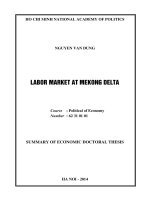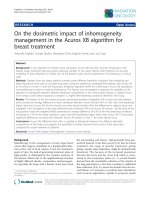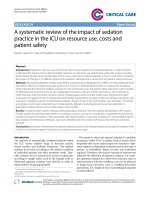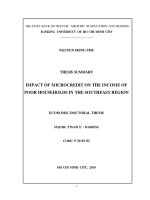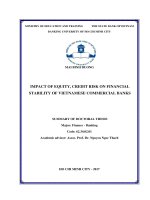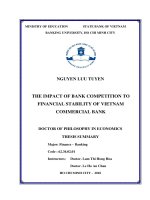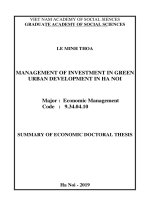Economic doctoral thesis: Impact of Microcredit on the Income of Poor Households in the Southeast Region
Bạn đang xem bản rút gọn của tài liệu. Xem và tải ngay bản đầy đủ của tài liệu tại đây (801.46 KB, 38 trang )
THE STATE BANK OF VIETNAM MINISTRY OF EDUCATION AND TRAINING
BANKING UNIVERSITY OF HO CHI MINH CITY
----------------------------------------------
NGUYEN HONG THU
THESIS SUMMARY
IMPACT OF MICROCREDIT ON THE INCOME OF
POOR HOUSEHOLDS IN THE SOUTHEAST REGION
ECONOMIC DOCTORAL THESIS
MAJOR: FINANCE - BANKING
CODE: 9 34 02 01
HO CHI MINH CITY, 2018
i
RELATED STUDY WORKS
I
The scientific study topics
1. Nguyen Hong Thu et. al., (2016). Solutions to improve the performance of
microfinance in Binh Duong. Approved on Aug 19, 2016. (Chairman of
scientific research topic at grassroots levels).
2. Nguyen Hong Thu et. al., (2017). Factors affecting the income of poor
households through microcredit activities in Binh Duong. Approved on Oct
31, 2017. (Chairman of scientific research topic at grassroots levels).
II
The scientific articles published in journals
1. Nguyen Hong Thu, Pham Cong Luan and Tran Thi Cam Van (2017). Poverty
reduction in Binh Duong from the perspective of microfinance. Journal of
Thu Dau Mot University. No. 02 (33), Apr 2017.
2. Nguyen Hong Thu (2017). Social capital with access to micro-credit of rural
households in the Southeast region. Journal of the Asia Pacific Economy,
Mar 2017.
3. Nguyen Hong Thu and Nguyen Van Diep (2017). Impact of resources on
income of rural households in Binh Duong province. Journal of Economic
Management. No. 81 (Mar + Apr 2017).
4. Nguyen Hong Thu (2017). Microcredit with income of the poor in rural
Southeast region. Journal of the Asia Pacific Economy, Apr 2017.
5. Nguyen Hong Thu (2017). Access to microcredit of households in the lacquer
village in Binh Duong. Banking Technology Magazine. No. 134, May
2017.
6. Nguyen Hong Thu (2018). The role of microcredit in livelihoods of poor
households in the Southeast region. Journal of Economic Management, No.
88 (Apr + May 2018).
ii
CHAPTER 1: INTRODUCTION OF STUDY OVERVIEW
1.1. The necessity of study topic
Along with the activities of microfinance, microcredit contributes to the
practical effect of poverty reduction. It is an important tool in the fight against the
poverty, especially in developing countries (Humle and Mosley, 1996; Shaw, 2004).
In spite of that, this conclusion is still a matter continuing to be discussed and
increasingly attracted many different opinions of researchers, with each study, the
authors have introduced, analyzed different aspects and fields. There are some
options that impact relation of microcredit on income is statistically insignificant
(Sen, 2008; Rukiye, 2012) or other options showed that they did not find the impacts
of microcredit on the income of households (Diadup and Zeller, 2001); the study of
Morduch (1998) found that credit from the Grameen Bank in Bangladesh reduced the
vulnerability rather than poverty reduction and the study of Coleman (1999) showed
that they found only a significant impact of microcredit on the welfare of households
in Thailand.
Up to now, the government in most countries has recognized the active role of
microcredit to poverty reduction, its science research activities on microcredit are
increasingly attracting attention from many experts as well as scholars in the country
and abroad. In order to continue the inheritance, to understand the impact of
microcredit on the income of poor households and especially in the Southeast region,
there is no research conducted yet, but in this study, theoretical framework is formed
on the background of theories, the analysis based on the practical characteristics of
the region to clarify the objectives set out in the study. Before this context, the study
proposes the key issues that need to be explored, that are (1) to check the theoretical
point that microcredit affecting poverty reduction through income factor of the
households is necessary, (2) to improve income for poor households, it is needed to
3
improve the access to microcredit to the households and (3) how to improve the
access to microcredit to the poor to have additional capital to improve their income?
Therefore, the study topic needed to be implemented is “Impact of Microcredit on
the Income of Poor Households in the Southeast Region”.
1.2. Overview of the study topic
As part of the microfinance activity, microcredit is recognized contributing to the
enhancement of self-reliance and capacity to create product value, opening
opportunities for the poor to develop their livelihoods to improve and enhance the
quality of life. In Vietnam, the famous typical studies of authors such as Nguyen Kim
Anh et al., (2011) with the study of microcredit to the poor in Vietnam - Verification
and comparison, or a series of other studies on the poor such as evaluation of poverty
reduction policies in Ho Chi Minh City (Phung Duc Tung et al., 2013), evaluation of
poverty reduction models of foreign partners in Vietnam (Nguyen Duc Nhat et al.,
2013), ... Most of the studies have high consensus on the effectiveness of microcredit
with the poverty reduction war of the country. The studies above outlined the basic
modes of operation of microcredit both in the country and abroad, evaluated and
analyzed the impact of microcredit on the ability to generate income from customers.
However, these studies have just mentioned overall the impact of microcredit on
income. The objective of this thesis is to clarify the issues mentioned in this study
and practical application in the Southeast region.
1.3. Objectives and questions
1.3.1. General objectives
The objective of this thesis is to verify the hypothesis of the microcredit impact on
income for poor households and to identify factors affecting the access to microcredit
of the poor households in order to find solutions to increase income through
increasing access to microcredit for them.
4
1.3.2. Specific objectives
Based on the general objectives of the research, the thesis sets out three
specific objectives that need to be addressed as follows:
Study the impact of microcredit on the income of poor households in the
Southeast region.
Understand the impact of factors on access to microcredit of the poor
households.
Recommend the solutions contributing to income increasing for the poor
households through enhancing the access to microcredit and other non-financial
activities for poor households in the region.
1.3.3. Questions for study
To achieve the target set out, the thesis shall answer the following questions:
Does microcredit affect the income of poor households? And how the levels
of impact are?
How the access to microcredit of the poor households is? What solutions
should be taken to increase the access to microcredit for poor households?
What policy recommendations contribute to increase the income for poor
households through microcredit activities in the Southeast region?
1.4. Object and scope of study
1.4.1. Object of study
Originating from the urgency of study and practice in the study area, the thesis
determining the objects to be clarified in this study is the income of poor households
(specifically, the income of the microcredit borrowers and the non-microcredit
borrowers).
1.4.2. Scope of study
5
1.4.2.1. Scope of space
Provinces of the Southeast region, including Binh Duong, Binh Phuoc, Dong Nai and
Tay Ninh province.
1.4.2.2. Scope of time
Studying to understand and analyze the secondary data sources from relevant local
reports in the period of 2011 - 2017. Time for survey implementation is 2016.
1.5. Approach, study method, study data sources
1.5.1. Approach
The study uses the systematic approach. The study uses qualitative in combination
with quantitative research method.
1.5.2. Analysis method of the study
The study uses the statistical, analysis method of related primary and secondary data.
The method interviews 15 experts. The survey method using semi-structured
questionnaire with the surveyed subjects as poor households in the area.
1.5.3. Source of study data
Secondary data source.
Primary data source.
1.6. New points and contributions of the thesis
1.6.1. Contribution in terms of practicality
Firstly, the thesis has practical application in the current period when the
whole country has made a re-evaluation of the poverty reduction and is stepping into
a new phase with the application of the multidimensional poverty (period 20162020).
6
Secondly, the thesis has proved that microcredit plays an important
contribution to poverty reduction strategy, especially in a Southeast region with a
high economic growth rate in the Southern key economic region of Vietnam.
1.6.2. Contribution in terms of academically
Firstly, the thesis summarizes the assessment comprehensively to the impact
of microcredit on the poor household incomes and affirms that microcredit is an
effective tool in poverty reduction strategy. Although there are still many
controversial discussions about the effectiveness of microcredit, within the scope of
this research, the thesis contributes to sum up relevant theoretical foundations. The
summing-up is meant to help the next researchers access the credit-income theory,
the theory to access microcredit, and the statistical implications with the impact of
microcredit, the impact of non-financial activities affecting the poor household
income.
Secondly, it compares and asserts that there is a difference in income between
the two groups of microcredit borrowers and non-microcredit borrowers. Particularly,
the group of microcredit borrowers has the average income higher than the group of
non-borrowers.
Thirdly, together with the microcredit activities, non-financial activities are
organized in parallel with the process of deploying financial resources to poor
households, which is assessed to be an efficient complementary activity, contributing
to improve the performance of microcredit with poverty reduction. This research
assumes that non-financial activity influences the ability to raise income to poor
households.
Fourthly, the social capital (SC), which currently has many studies to analyze
the influence of social capital on the participation in credit services in general, but the
understanding of the impact of social security on the access to microcredit in the
7
previous studies have not paid much attention; the thesis confirms that social capital
is an issue that is necessary to promote and expand during the performance of
poverty reduction strategy.
1.7. The structure of the thesis
The thesis consists of 5 chapters with the following contents:
Chapter 1: Introduction to study overview
Chapter 2: Overview of theoretical basis on microcredit to income of poor
households
Chapter 3: Research method
Chapter 4: Microcredit activities in the area and test results
Chapter 5: Conclusions of solutions
CHAPTER 2: OVERVIEW OF THEORETICAL BASIS ON MICROCREDIT
TO INCOME OF POOR HOUSEHOLDS
2.1. Micro credit
2.1.1. Concept
The term of “microcredit” shall be defined as “Microcredit is the provision of small
loans to poor, low-income borrowers to help them create the business, build the
asset, and increase the income”.
2.1.2. The role of microcredit for poverty reduction
Firstly, starting from the initiation by Prof. Muhamad Yunus from very small loans,
but it has helped thousands of poor workers have the opportunity to open the door to
earn the living. Although it is small loans, it comes to them when they need it most,
as a “lifebuoy” to help them overcome difficulties and obstacles. In Vietnam, the
small lending activity is provided by MFIs, financial institutions, NGOs or social
organizations in the formal, semi-formal and informal area (Nguyen Kim Anh et al.,
8
2011). Up to now, it still cannot deny the absence of the role of microcredit for
campaigns against poverty, especially in developing countries.
2.1.3. Overview of microcredit activities in countries around the world
Operation of Grameen Bank model in Bangladesh (GB)
Microcredit operation in Thailand
Microcredit operations in India
Microcredit operations in Indonesia
Microcredit operations in Canada
2.2. Poverty
2.2.1. Concept
Poverty: The World Bank (2011) considers that poverty is divided into different
levels: absolute poverty, relative poverty and poverty with minimal demands as
follows:
+ Absolute poverty: is the status that a part of the population in the poor area is
unable to satisfy the minimum demands of life: eating, wearing, living, traveling, ect.
+ Relative poverty: is the status that a part of the population in the poor area has the
living below the average living standard of the considered community and locality.
+ Poverty with minimum demands: is the status that a part of the population has the
minimum subsistence to maintain their livelihoods, such as enough food, clothing,
living and some daily activities but at a minimum level.
2.2.2. Poverty line of some countries in the world
The popular standard of calories/day in some ASEAN countries is as follows:
9
In India, the standard is 2250 calories/person/day. In Bangladesh, the standard is
2100 calories/person/day.
In Indonesia: In the early 1980s, the consumption of calories was 2100
calories/person/day as a standard to determine the boundaries between rich and poor.
In China: In 1990, the consumption of calories was 2150 calories/person/day.
Industrialized countries in Europe: 2570 calories/person/day.
2.2.3. Poverty line of Vietnam
In the 1990s, the poverty line in Vietnam was defined as: households with income per
capita in rural and mountainous areas are from 45,000 VND/person/month (540,000
VND/person/year) downwards. In rural and delta areas, the households with average
income per capita was VND 70,000/person/month (840,000 VND/person/year). In
urban areas, the income per capita was 100,000 VND/person/month (1,200,000
VND/person/year). In 2006, the poverty line in rural areas was 200,000
VND/person/month and in urban areas was 260,000 VND/person/month. In the
period of 2011-2015, the poverty line was 500,000 VND/person/month (urban area)
and 400,000 VND/person/month (rural area)
2.3. Income
2.3.1. Concept
The General Statistics Office (GSO) (2011) defines that: Income is the total amount
of money that a person or family earned in a day, a week or a month, or more
specifically, all that a person earned when devoting the work force properly, so it is
called income. The monthly income per capita is calculated by dividing the total
income in year of the household by the number of household members and dividing
by 12 months.
10
2.3.2. Factors affecting income
The income of each individual is obtained from devoting the work force,
participating in labor activities. The contribution of labor force of each individual
brings income to each individual and family. That contribution brings economic
value to the family through daily, monthly or even annually income for the
household. Therefore, to create the valuable products, it requires a combination of
physical capital and human capital (Ismail and Yussof, 2010). The combination of
human capital and physical capital produces the labor value expressed by the added
value of income achieved. In human labor activities, these two inseparable factors as
follows.
- Relationship between financial capital and income
Capital is considered as a “lever” for the process of economic growth and
development, a stimulation of the process of expanding the scale of production,
implementation of economic projects and a contribution to increase the benefits,
create the momentum to the economic development process. When credit markets are
limited, the producing decision of a household depends on the price of market
efficiency, p, the characteristics of production and the characteristics of access to
credit shall be: q q ( p
q h
K ).
- Difference in income
The Neoclassical economists gave the theories: Human capital theory, income and
discrimination theory, production theory ... to explain the fundamental differences in
the income of individuals or households. Thus, the income is a multivariate function
depending on many different factors (Y =f (x 1,x2,x3 …xn). Today, to analyze the
impact of factors on income, the function most commonly used in the analysis is the
Cobb-Daughlas function. The Cobb-Daughlas function has the form as follows:
Y = A.X1α1 . X1α2 . Xnαn.eβiD+xiD1+λiD2
11
In which, Y is the income; A is the constant; Xi (i 1, n) is the independent variable
affecting the dependent variable, Y, (income). The hypothesized independent
variables include credit, household characteristics, environmental factors and related
policies; e is factors other than factor Xi. In addition to the Cobb-Daughlas function,
there is also a semi-logarithm function: LN(Y)=β0 +β1 X1+β2X2 +…+βnXn+ei (Mincer,
1974). Or multivariate linear function such as Y = β0 + β1X1 + β2X2 +…+ βnXn + ei is
also widely used to estimate household income. From here, the study selects the
proposes the research model that is a regression model with the form of multivariable linear function to evaluate the impact of microcredit on income of poor
households as follows:
Y = β0 + β1 X1 + β2 X2 +…+ βnXn + ei
2.3.3. Microcredit for income generating activities
Microcredit is needed to help poor households generate income (Krog, 2000).
Microcredit activities are used in developing countries and are highly effective in
poverty reduction, especially microcredit focuses on women customers in rural areas,
who have no accessibility capital resources from other financial institutions by
barriers on collateral and complex and cumbersome procedures, helping them to
create jobs and generate income (Mohanan, 2005).
2.4. Overview of access credit theory and barriers to access to credit
2.4.1. Asymmetric information in credit transaction and credit restriction
Asymmetric information occurs when the borrower understands their ability to repay
their loans while the lender does not know the borrower’s limitations. At the same
time, the borrower does not collect enough information about the loan or the lending
institutions. As a result, the borrower desires to borrow but cannot access to the loan;
and the lender does not know the customers who need the loan and bringing about the
12
consequences associated such as lending under the relationship, other complicated
and cumbersome procedures such as collaterals, guarantors, etc. But to meet these
conditions, most small and micro enterprises, poor households and low income
households cannot meet this condition.
2.4.2. Social capital, measurement of social capital and accessibility to credit
Until 1990, the American sociologist, James Coleman, gave the concept that social
capital as the characteristics in the everyday life, social networks, norms, and social
trust helps members in the society to work together effectively to achieve the
common goals. Bourdieu (1986) defines that social capital is derived from a direct
or indirect network, and is a durable network of interrelated relationships that are be
acquainted and recognize each other.
2.4.3. Characteristics of households, environmental factors and policies with
access to credit
Environmental factor with the distance on geographic gap, housing location and
characteristics of the living area, and the inadequacy of imperfect information make it
difficult for customers to access capital but they have to deal with difficulties to
access (Le Khuong Ninh, 2016, Nguyen Trong Hoai, 2005). People who want to
borrow cannot borrow and people who do not need the loans are more likely to get
access, thereby creating distorting motives when borrowing, to get the loans, people
who want to borrow seeks the way to get loans through the relationship, leading to
asymmetry in the supply and demand of credit in the financial market.
2.5. Overview of relevant research documents
13
Table 2.2. Summary table of relevant research results
Studies
Object and scope
of study
Study method
Study results
Microcredit with income
Quach Manh
(2005)
Phan Dinh
(2012)
Hao Access to credit
and
poverty
reduction in rural
Vietnam
With a cross-sectional dataset and Characteristics
of
household
econometric model analysis through affecting the access to credit and
the field survey data and the income of poor households
population living standard survey
dataset VLSS 1992/1993 VLSS and
VLSS 1997/1998
Khoi Living standards of With a cross-sectional dataset for The impact of microcredit on income
poor households in survey in the Mekong Delta, the study has not been demonstrated clearly in
the Mekong Delta used the Propensity Score Matching this study.
(PSM) technique and Instrumental
Variable (IV-PE) method in the
statistical analysis.
Phung Duc Tung et The
work
of Quantitative and qualitative method Credit has
poverty reduction with discontinuous regression model reduction
al., (2013)
in Ho Chi Minh in the study
City in period of
2009-2013
14
impact
on
poverty
Dinh Phi Ho & Income of poor
households
in
Dong Duc (2015)
Vietnam in the
period of 20062012
Mohanan (2005)
Islam and
(2010)
The study uses the Difference in Credit has officially impacted on
Differences (DID) method to assess household incomes and expenditures.
the impact of formal credit on
incomes and expenditures of farmer
households
Study
the Qualitative research method
microcredit
activities in India
Microcredit affects the incomegenerating capacity of the poor,
empowering the women position.
Ahmed Study
the Quantitative method with statistical Microcredit affects the ability to do
microcredit impact analysis through SEM linear model
business, create jobs, and build assets
on
income
of customers
generating
activities
of
customers
Brown (2010)
Study
the Qualitative research method
microcredit impact
on
economic
development, job
creation
and
income generation
role
Ahmed et al., (2011) The
microcredit
Microcredit offers borrowers the
opportunity to increase the labor
changes, diversify the livelihoods for
poor households
of The qualitative analysis method with Microcredit
in the analysis of random interview data
15
has
no
statistically
economic
from 20 people surveyed
development
and
poverty reduction
significant impact
Vitor et al., (2012)
Microcredit with Quantitative research method with Microcredit helps improve the
income of women logit regression model, survey data business skills and generate the
from
300
microcredit
women income of credit women borrowers.
in Central Ghana
borrowers
Rykiye (2012)
Study
the The survey data analysis method from
microcredit
with 2,036 observations of poor households
income change of in Turkey
participating
members
Ayen (2016)
Study
the Quantitative analysis method with There is a difference in income
differences
in Propensity Score Matching (PSM) between
borrowers
and
nonincome
of from the female head of household borrowers
microcredit
survey dataset at Jimma Zone
borrowers and nonborrowers
MICROCREDIT does not have an
impact on income, microcredit
borrowers as a normal need for
capital.
Accessibility to credit of households
Nguyen Quoc Oanh Study the accessibility Quantitative method with two- The monthly income and purpose of
and Pham Thi My
step regression technique of borrowing affects accessibility to
16
Dung (2010)
of formal credit
Heckman (1999) through a formal credit of households.
survey dataset of 116 households
Nguyen Phuong Le Accessibility to formal Statistical method describes the The families with better economic
and Nguyen Mau credit
resources
of survey data from 60 households conditions can access higher credit
interviewed based on the pre-set
Dung (2011)
farmer households
questionnaire structure
Phan Dinh
(2013)
Khoi Formal and informal Statistical analysis based on Income, employment of households
accessibility of farmers survey data of 358 observation affect accessibility of households.
samples
from
919
rural
in the Mekong Delta
households
Tran Ai Kiet and Accessibility to formal Statistical analysis based on the The values of assets, income, and
Huynh Trung Thoi credit of farmers in An survey results of 150 farmer purpose of borrowing affect the
accessibility to formal credit of
(2013)
Giang
households in the studied area
farmer households.
AFD (2008)
Accessibility
to Causal analysis compares the Rural households may participate
microcredit of rural ability
to
borrow
from more in microcredit loan when they
have stable income and are not
households in Morocco
microcredit
affected by seasonal factor.
Ibrhim and
(2013)
Bauer Access to microcredit Quantitative method with probit The characteristics of households
and the impact of the regression technique
with members with good production
microcredit approach to
experience can access more
17
income
of
households
Masud
(2014)
and
farmer
Islam Study the social capital
with access to credit of
households
in
Bangladesh
Quantitative method with probit Social capital affects the access to
regression technique through credit of households
random survey data from 153
households in Bangladesh
Source: Summaries of the author
18
2.6. Theoretical foundations forming theoretical frameworks for study and
the establishment of research hypotheses
Theory of capital resource of Ismail and Yussof (2010) shown that income is
formed by physical capital and human capital. Physical capital is acquired by
themselves or borrowing in the form of monetary or physical (physical is shown
in the form of assets, labor materials, means of production, etc.). Human capital
is gained through the labor accumulation, which is the skills and knowledge
accumulated during the learning and life experience. During creating value for
labor product, it cannot lack one of these two elements above; they complete
each other and indispensable in every human activity. Human capital is
involved in the operation, creation on the basis of physical capital and vice
versa. Thus, when considering the income of an individual, a family needs a
general assessment of the many factors that make up the value of income.
Therefore, to assess the income of poor households, it is necessary to assess
overall between the income and access of microcredit of households. Speeding
up income for poor households on the basis of increasing access to microcredit
for poor households. With the above arguments, the thesis establishes two
research models and needs to be clarified in the study and theoretical
framework of the study formed as Figure 2.2.
Social capital
Microcredit
Household
characteristics
Household
characteristics
Access
to MC
Income
Environment and
preferential credit
policies of the locality
19
Environmental
characteristics and
non-financial
activities
Figure 2.2. Theoretical framework for study
Source: The author proposes based on theory foundations and previous studies
Based on the above studies and based on the arguments of the research theory
foundations, the thesis formed hypothesis on income of households affected by
the following groups of hypothesis:
(1) Microcredit (group of hypothesis H1);
(2) Household characteristics (employment, number of labor generating jobs,
number of dependents in the family - group of hypothesis H2);
(3) Environmental characteristics and non-financial activities (group of
hypothesis H3)
Thus, it shown that, in order to promote the income increasing, it requires to
increase accessibility to microcredit for them. The thesis establishes a
Microcredit access model based on the foundations of the previous theory and
studies. The summarized groups of hypothesis are included:
(1) Social capital (group of hypothesis H4);
(2) Household characteristics (income, employment - group of hypothesis
H5);
(3) Environment and preferential credit policies of the locality (group of
hypothesis H6).
2.7. Gaps in research
Through examine summarily the relevant studies, most studies affirm that
microcredit offers many benefits to the poor such as increasing welfare,
increasing empowerment for women, generating income and improving the
living.
By this argument, it shown that the gaps should continue to be inherited and
clarified in the study are: (1) the study of the microcredit impact on the income
of poor households and to find out whether there is the income difference
between two groups of microcredit borrowers and non-borrowers? (2) the
20
specificity of the study area and (3) through the specificity of the area, to
determine the impact of microcredit through the value of income and to increase
the income and to increases the accessibility of microcredit for poor households,
what limitations affects the accessibility of microcredit of poor households ?
From these gaps, the thesis continues to inherit previous studies and clarify gaps
in this research thesis.
2.8. Conclusions of Chapter 2
Chapter 2 summed up the relevant theoretical foundations, examined summarily
the studies in the country and abroad, and related studies; from that, the thesis
has developed a theoretical framework for study.
CHAPTER 3: STUDY METHODS
3.1. Study models
As presented in the arguments of study theory in Chapter 2, the study uses a
multivariate linear regression model with the hypothesis of microcredit impact
on the change of poor household income and the Binary Logistic regression on
the hypothesis of access factor to microcredit.
3.1.1. Microcredit model affects the income of poor households
The thesis uses a multivariate linear regression model to test the study
hypothesis. The analytical techniques through linear regression model, and the
model has the following form:
Y = β0 + β 1 X1 + β 2 X2 + ... + β 9 X9 + e (3.1)
e: Residuals
β0: Vertical axis-cutting factor;
β1 to β9: Regression coefficient (correlation) of the variable X1,..X9.
21
Dependent variable, Y: Per capita income of the poor household, measured by
the total income of the household divided by the number of household members
(unit: million/year).
The model should go through the system with the following 6 tests:
Firstly, Test the partial correlation of the regression coefficients
Secondly, interpretation level of the model
Thirdly, suitability level of the model
Fourthly, phenomenon of collinearity
Fifthly, test the autocorrelation of residuals
Sixthly, Heteroskedasticity
3.1.2. Model of factors affecting access to microcredit
Logistic regression model:
∑
(3.2)
In which: Y: The dependent variable has two states (0,1); X1, X2…Xi is the
value of independent variables; β0 is the estimated value of Y when the
variables X value 0; βk is the regression coefficients; u is residual.
According to Cox, D.R (1970), the general form of the Binary Logistic
regression model is as follows:
= β0 + β1 X1 + β2X2 + …βnXn (3.3.)
In which, P (Y=1)=P 0: Probability of households access to microcredit; and
P(Y=0)=1-P: Probability of household not access to microcredit.
[
]
22
Take 00 =
; with 00: Odds Coefficient
LnO0 = β0 + β1X1 + β2X2 + …β7X7
(3.5)
Therefore, Log of Odds coefficient is a linear function with independent variables
Xi (i 1, 7) . Equation (3.5) has the form of a logit function.
According to Agresti (2007), the model is approved the test system includes:
Firstly, the Wald test. Secondly, test the suitability of the model. Thirdly, test the
level of interpretation of the model.
3.1.3. Developing the basis for variable selection in study models
3.1.3.1. Microcredit model affecting income (M1)
MICROCREDIT
(hypothesis H1)
Microcredit is expressed
through factors: loan scale,
interest rate, loan term and
loan purpose
Number of dependents
HOUSEHOLD
CHARACTERISTICS
(hypothesis H2)
Labor scale
INCOME
Employment
ENVIRONMENTAL
CHARACTERISTICS AND
NON-FINANCIAL
SUPPORT POLICIES
(hypothesis H3)
Environmental risks
Non-financial policies
Figure 3.1: Model of impact of microcredit on household income
Source: Propose to study based on theoretical framework and previous studies
23
Selected variable Hypothesis
Basis for variable selection
[X1]. QM_VON
Bateman’s Theory (2010) and Janvry’s Theory (1995)
[X2]. TH_VAY
Brown’s studies (2010); Islam and Ahmed (2010);
[X3]. L_SUAT
H1
Vitor et al., (2012); Ibrahim and Bauer (2013),
Banerjee and Dulfo (2016); Alhassan and Akuduga
[X4]. MD_VAY
(2012). Vitor et al., (2012).
[X5].
Dinh Phi Ho and Dong Duc (2015)
S_PTHUOC
[X6].
World Bank (2012); Ismail and Yussof’s Theory
QM_LDONG
(2010); Dinh Phi Ho and Dong Duc (2015)
H2
[X7]. V_LAM
World Bank (2012); Ismail and Yussof’s Theory
(2010); Dinh Phi Ho and Dong Duc (2015)
Janvry’s Theory (1995), Dinh Phi Ho and Dong Duc
[X8]. R_RO
(2015)
H3
Manganhele (2010), Phung Duc Tung et al., (2013);
Banerjee and Dulfo (2016); Boamah and Alam (2016);
[X9]. CS_TPC
Nguyen Duc Nhat et al., (2013); Alhassan and
Akuduga (2012).
Source: Summarize from theory foundations and previous studies
3.1.3.2. Microcredit access model (MH2)
24
Social capital (hypothesis H4):
Participating in social capital,
frequency of participating in social
capital
Household characteristics
(hypothesis H5):
Income, employment
Access to
microcre
dit
Environmental
factors
and
preferential credit policies of the
locality (hypothesis H6): The
housing location of the households,
living area and preferential policies
of the locality
Figure 3.2. Microcredit access model
Table 3.2. Summarize the foundations for developing variables for the
microcredit access model
Selected variable Hypothesis
Basis for variable selection
[X1]. VON_XH
Masud and Islam (2014); Putnam (1995); Baurm and
[X2].
Ziersch (2003); Stone (2001); Kilpatrick (2002); Ajam
TS_TGVXH
H4
(2009); Lin et al., (20010); Okten (2004).
AFD (2008); Tran Ai Ket and Huynh Trung Thoi
[X3]. V_LAM
(2013); Phan Dinh Khoi (2013).
Brown (2010); Armed et al., (2011); Vitor et al.,
H5
[X4]. T_NHAP
(2012); Ibrahim and Bauer (2013) Mohannan (2005),
Phan Dinh Khoi (2013). Tran Ai Ket and Huynh Trung
Thoi (2013).
25

